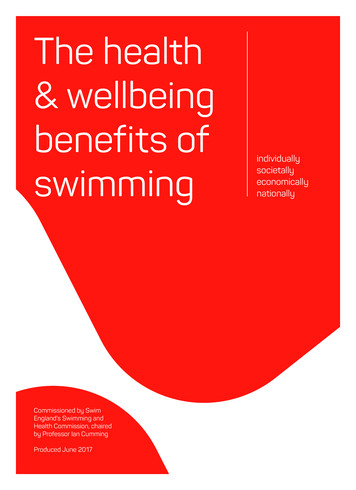
Transcription
The health& wellbeingbenefits allyCommissioned by SwimEngland’s Swimming andHealth Commission, chairedby Professor Ian CummingProduced June 201715067 EW ASA Cover4pp.indd 1108/06/2017 15:14
15067 EW ASA Cover4pp.indd 208/06/2017 15:14
This report was produced by theSwimming and Health Commission.The Commission was established bySwim England to identify evidence forthe health benefits of swimming andto promote future research in this area.Although established by Swim England,the Commission operates entirelyindependently under the chairmanshipof Professor Ian Cumming.15067 EW ASA Contents.indd 208/06/2017 15:18
15067 EW ASA Contents.indd 308/06/2017 15:18
ContentsForewordIntroductionGlossary & definitions050607Chapter 1The individual physical health benefits of swimming:a literature review08Chapter 2The wellbeing benefits of swimming:a systematic review26Chapter 3The physiological effects of swimming:a systematic review44Chapter 4The wellbeing benefits of swimming to communities:a literature review106Chapter 5The public health benefits of swimming:a systematic review118Chapter 6Swimming as a sport – the health and wellbeing benefits:a systematic review134Chapter 7Swimming for health and wellbeing:the economic case15067 EW ASA Contents.indd 414608/06/2017 15:18
ForewordWhether it’s for leisure, pleasure or competition, swimming is a great way to improve your health and wellbeing.These are the key themes from a scientific report commissioned by Swim England on the health and wellbeingbenefits of swimming. The evidence from this report is an important landmark and shows that:ww Swimming is one of England’s most popular sportsww Swimming may be associated with a decrease in early death due to cardiovascular disease and any other causeww Swimming can have a number of health and wellbeing benefits for individuals, patients, communities, the publicand the nationww There is emerging scientific data for the physical and mental health benefits of swimmingww Research on swimming and health benefits is sparse and sporadic. Specific areas of further research needto be developedww The future now offers opportunities for Swim England to lead on a strategy that engages with and retains thepublic passion for swimming for health and wellbeingGoing forward, it will be important to link the health, economic and wellbeing benefits of swimming as a key strategyto address the physical inactivity epidemic in this country. We also need further research on the specific health andwellbeing benefits of swimming.This is not the time to tread water; we need to enrich and harness the evidence and opportunity, and to encouragemore to swim, and swim regularly. We need to move as a nation to take more exercise. So do swim for pleasure,leisure, or as a sport.Professor Dame Sally C. DaviesChief Medical Officer for EnglandForeword15067 EW ASA Contents.indd 5508/06/2017 15:19
IntroductionSwim England’s ‘Swimming and Health Commission’ is the first time that the relationship between swimming andhealth and wellbeing has been scientifically investigated in this depth. Swim England is the national governing bodyfor the sport in England and they commissioned this work to provide a baseline of knowledge from which to buildfuture evidence and share best practice.An independent team of United Kingdom (UK) researchers have reviewed and scrutinsed the available evidence forthe Commission on the benefits of swimming for: individuals, patients, communities and nations. Their scope wasto scientifically review the health and wellbeing benefits across the lifespan, to highlight disparities in evidence,practice and access, and to evidence the many health advantages that swimming regularly affords to us all.It is clear from the evidence that being able to swim, swimming regularly, and swimming as a part of daily communitylife can have considerable health and wellbeing benefits. For instance, research has identified that any amount ofswimming participation compared to those who engaged in none, was associated with a 28% and 41% reductionin all cause and cardiovascular disease cause mortality respectively. The striking evidence of where swimming hasafforded significantly improved health, quality of life and a sense of community are additional examples of bestpractice that need to be promoted across the nation.And it is evident that water-based exercise can confer several specific advantages, as compared to land-basedexercise. For this reason, water-based exercise prescription should be a key consideration for all health careclinicians, providers and commissioners.It is also emphasised that having adequate opportunities to learn to swim and have positive experiences in early life,particularly among those from disadvantaged backgrounds, may be an important step to tackle drowning as one ofthe causes of avoidable and tragic death.It is estimated that those who swim for recreational or competitive purposes are eight times more likely to meetphysical activity guidelines. Long-term swim training can also improve cardiorespiratory fitness or endurance inhealthy pre-pubertal girls and adults, women during pregnancy, children with asthma, and adults with osteoarthritis(a condition affecting joints, causing pain and stiffness).It is however concerning to find in many areas a profound lack of robust scientific evidence in swimming as acontemporary means to: increase physical activity levels, move the inactive into swimming as a preferred physicalactivity, and to use a variety of community swimming venues to promote health and wellbeing at population levels.This report is just the start of a focus on swimming being a greater part of the national and international picture toincrease health and wellbeing through physical activity, leisure and water based sports.This full scientific report of the commission is divided into seven chapters. Each chapter contains a review of theevidence for the health benefits of swimming together with key points and summary statements. Chapter onefocuses on the individual health benefits of swimming and other water based activities. Swimming and mental healthand wellbeing is covered in chapter two. The physiology of swimming and health benefits is detailed in chapterthree. Chapter four explores the evidence for swimming benefits for communities within a framework of deliveringcommunity capacity. Chapter five details the public health benefits of swimming and the importance of fulfillingkey societal priorities such as reducing the number of deaths by drowning. Chapter six describes the benefits ofswimming as a sport and the final chapter seven looks at the economic case for swimming. A summary of this fullreport is available as a separate document and highlights the key points from each chapter.Introduction15067 EW ASA Contents.indd 6608/06/2017 15:19
Glossary and definitionsSwim England is the national governing body for swimming in England. The organisation and network helps peoplelearn how to swim, enjoy the water safely, and compete in all their sports.Swimming is the sport or activity of propelling oneself through water using the limbs. In the context of this summaryit includes all forms of swimming and water based activities.Physical Activity (PA) is any volitional movement of skeletal muscle that results in energy expenditure is regardedas physical activity.Exercise is a form of leisure-time physical activity that is planned, structured, and repetitive. Exercise training ispurposeful and is performed with specific external goals, including the improvement or maintenance of physicalfitness, physical performance or health.Sport is a form of physical activity that includes rules and is usually competitive.Metabolic Equivalents (MET). Physical activity is measured in METs e.g. the energy it takes to sit quietly. For theaverage adult, this is about one calorie per kilogram of body weight per hour. Moderate intensity activity is those thatused 3 – 6 METS and vigorous activities more than 6 METs.Glossary and definitions15067 EW ASA Contents.indd 7708/06/2017 15:19
Chapter 1The individual physical health benefits of swimming:a literature reviewDr Fiona Moffatt, The University of NottinghamKey words:swimmingswimming poolaquatic therapyhydrotherapy815067 EW ASA Chapter 1 - p8-25.indd 808/06/2017 15:22
IntroductionThe global pandemic of physical inactivity is well recognised with concomitant implications for global health(Andersen et al., 2016). In the United Kingdom (UK), a significant proportion of children, adolescents and adults failto meet the national recommendations for physical activity: 90% of 2-4 year olds, 80% of 5-15 year olds (BHF,2015), and 39% of adults (BHF, 2017). Similar patterns are seen globally (Hallal et al., 2012). The cost of such physicalinactivity is high – globally, the economic burden of physical inactivity in terms of healthcare costs, productivitylosses and disability adjusted life years amounts to 51.5 billion per annum (Ding et al., 2016).An intimate relationship exists between physical (in)activity and physical health (Reiner et al., 2013). Sedentarybehaviour is associated with adverse cardiometabolic adaptations such as insulin resistance, altered lipid trafficking,muscle fibre type alteration and ectopic fat storage (Saunders et al., 2014). Poor cardiorespiratory fitness/physicalinactivity is a significant risk factor for the majority of non-communicable diseases (NCDs), including cardiovasculardisease, dementia, certain cancers, osteoporosis, obesity and Type 2 diabetes (Lee et al., 2012; Reiner et al., 2013).It is also the strongest independent risk factor for development of post-operative morbidity and mortality(Snowden et al., 2013).A multi-agential approach to promoting physical activity has been highlighted as imperative to the promotionof national and international physical activity (PA) guidelines (Gates et al., 2016). These guidelines detail therecommended amount of physical activity required to achieve physical health benefits for young children (at least180 minutes per day), children aged 5 and over (at least 60 minutes per day), and adults (at least 150 minutes ofmoderate intensity activity per week, plus two episodes of strength/balance training)(Department of Health, 2011).Physical activity may be multi-modal, including activities such as walking, jogging/running, aerobics, racket sports,swimming, cycling. Adults who are physically active have a reduction in all-cause mortality of up to 30% comparedto sedentary individuals and a reduced risk of developing chronic disease (Kokkinos, 2012). Furthermore, evidencesuggests that physical activity and exercise interventions produce similar results to drug therapy in terms ofmortality outcomes in the secondary prevention of coronary heart disease, rehabilitation post-stroke, treatment ofheart failure and prevention of diabetes (Naci and Ioannidis, 2013).This chapter presents a contemporary review of the empirical evidence in relation to swimming and aquatic exercise,and physical health. Specifically, it will aim to elucidate how swimming/aquatic exercise influences the physicalhealth of the general population and, additionally, certain specific sub-groups or those with chronic disease.Why might swimming influence physical health?Most studies exploring the relationship between physical activity and physical health have used interventions suchas walking, cycling, running or aerobics classes (Chase et al., 2008a; Mohr et al., 2014). Of interest are the uniquefeatures that aquatic based exercise offers, and how swimming and aquatic exercise relate to health outcomes.Swimming and other forms of aquatic exercise (aqua-jogging and aqua-aerobics for example) are some of the mostpopular choices for meeting physical activity recommendations – both for the aerobic and strength/balance element(Lazar et al., 2013). Exercise in an aquatic environment confers many benefits – minimised weight-bearing stress, ahumid environment and a decreased heat load (Yuan et al., 2016). This may offer a personalised exercise opportunityfor particular populations, especially the elderly, pregnant women, and those with arthritis, type 2 diabetes,disabilities or excess adiposity (Delevatti et al., 2015; Lazar et al., 2013). The unique nature of swimming and aquaticexercise will be considered.The aquatic environment has been recognised as a place for active play and recreational exercise since thenineteenth century (Wiltse, 2013). Chase et al. (2008) compared the health aspects of swimming with alternativeforms of aerobic exercise, and sedentary behaviour. Participants included 10,518 women and 35,185 men aged 2088 years old; the majority were Caucasian and of middle/upper socio-economic status. Screening included a formalsubjective and objective history, anthropometric measurements, blood tests and a graded exercise test. Participantswere categorised as ‘sedentary’ (no participation in activity over the previous three months), ‘walkers’ (primarilyengaged in run/walk/jog at a pace 15min/mile), ‘runners’ (primarily engaged in run/walk/jog at a pace 15min/mile), and ‘swimmers’ (exclusively engaged in swimming activity). The results demonstrated that all types of physicalChapter 1The individual physical health benefits of swimming:a literature review15067 EW ASA Chapter 1 - p8-25.indd 9908/06/2017 15:22
activity produced demonstrable health benefits in comparison to a sedentary lifestyle. Of all the groups, swimmingand running achieved the highest treadmill test duration/maximal metabolic equivalent (MET) levels, although theBody Mass Index (BMI) of swimmers was significantly higher than that of runners. It is worthy of note however,that the ‘swimmers’ category only formed approximately 1% of the total participant population, and therefore thiscould affect the internal validity of the study. Equally, the limited demographics of the population could adverselyaffect external validity. The authors, however, conclude that swimming constitutes a valuable lifetime activity thatappears to produce healthy levels of cardiorespiratory fitness and, as such, is a viable alternative to other forms ofexercise. This is further supported by the results of a prospective study of the health effects of physical activity andfitness in men (n 40,547), that concluded that swimmers had lower mortality rates than those who were sedentary,walkers or runners even after controlling for age, body mass index, smoking/alcohol and family history (Chase etal., 2008b). Similar results have been demonstrated by Oja et al. (2015); in a cohort study of over 80,000 Britishadults, swimming participation was associated with a significantly reduced risk of all-cause mortality of 28%, andcardiovascular disease mortality of 41%.Clearly, the aquatic environment offers scope for aerobic activity, however the specific interaction betweenphysiological and hydrodynamic effects of immersion are also of particular interest and are thought to conferadditional effects/advantages (Chase et al., 2008b); Becker (2009) describes these in detail (Table 1).Table 1:Hydrodynamic principles of water immersion (after Becker, 2009 and Brody and Geigle, 2009)Hydrodynamic principleEffectDensityThe human body density is slightly less than that of water, therefore the volume ofwater displaced weighs more than the immersed body resulting in an upward forceequal to the volume of water displacedHydrostatic PressurePressure is proportional to the liquid density and the immersion depth. Hydrostaticpressure results in plastic deformation of the body, shifting blood towards the heart,raising right atrial pressure, and causing a cephalad displacement of the diaphragmBuoyancyImmersion to the xyphoid offloads bodyweight by 60% or more, to C7 by 75% ormore. Buoyancy results in ‘offloading’ of peripheral and spinal jointsViscosityLimb movement in water is subject to drag force and turbulence. Viscous resistanceoffers opportunities for strength training via the principle of loadingThermodynamicsWater may be used over a wide range of temperatures due to its heat capacity andconduction properties. Many public pools operate at 27-29 C, although sometimesincrease to 33.5-35.5 C for ‘therapeutic’ sessions. Neutral temperatures provide asafe and comfortable environment for exerciseIn total, the effects of swimming and aquatic exercise on physical health are sequelae of both aerobic training, andthe unique properties of water as an exercise medium. The following sections will consider the evidence to supportthese beneficial health effects, from a body system perspective.Effects of swimming on cardiovascular and cardiometabolichealthDisplacement of blood into the thoracic vasculature (secondary to the hydrostatic pressure gradient) results inincreased venous return, a 60% increase in central blood volume, increased cardiac preload, a concomitant increasein stroke volume of approximately 35%, and a reduction in heart rate secondary to baroreceptor stimulation (Becker,2009; Brody and Geigle, 2009; Lazar et al., 2013; Weston et al., 1987). Immersion to the neck also reduces systemicvascular resistance via a reduction in sympathetic vasoconstriction and nitric oxide release; this state continuesinto the post-immersion period (Becker, 2009; Lazar et al., 2013). Whilst systolic pressure increases with physicalactivity, this is generally less than on land; end-diastolic pressures are decreased (Becker, 2009).Chapter 1The individual physical health benefits of swimming:a literature review15067 EW ASA Chapter 1 - p8-25.indd 101008/06/2017 15:22
Upon commencement of aerobic exercise (specifically aqua-jogging), oxygen consumption is noted to be greaterfor a given speed of ambulation, therefore a beneficial training effect may be realised at a slower speed than onland (Evans et al., 1978). Lazar et al. (2013) note that, given the viscous resistance of water, the energy cost ofswimming a given distance is approximately four times that of running the same distance. Whilst it has been longsuggested that swimming is associated with a lower maximal oxygen consumption(VO₂max ) than other aerobicexercise (Holmér and Astrand, 1972), data are in fact equivocal; Lazar et al. (2013) suggest that these differences areattributable to factors such as swim skill/speed, clothing, water temperature, and baseline cardiac status.1. Swimming/aquatic exercise and risk factor modificationAerobic exercise is recommended as a cardioprotective lifestyle intervention, reducing cardiovascular mortalityin both genders and across the life span (Nagle et al., 2017). However, the effect of swimming on blood pressuremodification has produced inconsistent results (Lazar et al., 2013). In normotensive subjects, swim training has beenassociated with a small rise in systolic and diastolic blood pressure (Chen et al., 2010; Cox et al., 2006). It shouldbe noted however, that this rise was not clinically significant as it did not take participants into the hypertensivecategory (Lazar et al., 2013). Conversely, in male and female subjects, with varying severities of hypertension,swimming has been consistently associated with a reduction in blood pressure and improvements in vascularfunction such as carotid artery compliance, flow-mediated dilatation and cardiovagal baroreflex sensitivity (Arca etal., 2014; Bartels et al., 2016; Chen et al., 2010; Laurent et al., 2009; Mohr et al., 2014; Nualnim et al., 2012; Tanaka,2009). Swim/aquatic exercise training at moderate to high intensity, may confer greater anti-hypertensive benefits,however further research is warranted (Mohr et al., 2014; Nagle et al., 2017).Obesity is a major public health concern and associated with significant cardiovascular and cardiometabolic comorbidity (Boidin et al., 2015). Between 1971 and 2002, obesity increased three-fold amongst children and two-foldamongst adults, with significant disparities in ethnic groups (Stempski et al., 2015). As forms of aerobic activity,swimming and aquatic exercise are legitimate choices for weight reduction and management (Lazar et al., 2013).Aerobic activity is associated with decreased body fat, attenuation of loss of lean body mass commonly seen duringdietary restriction, and reduction of visceral adipose tissue (Klijn et al., 2007). For obese individuals, the unique natureof the aquatic environment, specifically the ability to reduce weight-bearing and thermoregulatory stressors, mayconfer an added advantage relative to other forms of aerobic exercise. Studies regarding the effects of swimmingand aquatic exercise on body composition have, however, been variable (Lazar et al., 2013; Meredith-Jones et al.,2011). Some researchers have shown no significant changes in body weight, percentage body fat or fat distributionwith swimming or aquatic exercise programmes (Gwinup, 1987; Tanaka et al., 1997). Others have demonstratedsignificant improvements in the same parameters in healthy and Type 1 diabetic young women (Sideraviciūte et al.,2006), sedentary older women (Cox et al., 2010), obese adults (Boidin et al., 2015), Type 2 diabetic men (Cugusi et al.,2015), adults with coronary artery disease (Volaklis et al., 2007), and post-menopausal women (Colado et al., 2009).The confounding factors underpinning conflicting results may be attributed in part to discrepancies in: programmetype, intensity and duration; addition of caloric/dietary restriction; or differences in baseline parameters (MeredithJones et al., 2011).Interest has been expressed in the effects that swim training and aquatic exercise may have on blood lipids,glycaemia, and insulin sensitivity, known aetiological factors in the genesis of cardiometabolic morbidity (Lazar et al.,2013; Meredith-Jones et al., 2011). The augmented atrial pressures associated with immersion are known to causeneural and hormonal adjustments, including suppression of the renin-angiotensin-aldosterone system (RAAS) (Lazaret al., 2013). Activation of the RAAS has been associated with development of conditions such as obesity and Type2 diabetes (Delevatti et al., 2015). A recent systematic review sought to better elucidate the relationship betweenaquatic exercise and glycaemic and lipid profile variables (Delevatti et al., 2015). Eight studies considered theeffects of prolonged aerobic training (8-24 weeks), with variable exercise protocols and session duration/frequency.Participants included both sexes, a range of age groups, and individuals with coronary artery disease, chronicheart failure, Type 2 diabetes and dyslipidaemia. All studies demonstrated improvement in at least one variablewhen compared to the control group or pre-training measurements. Only one study compared aquatic exerciseto land-based exercise, however, the biochemical improvements seen in both were not significantly different. Theauthors conclude that, despite methodological limitations, there is some evidence to indicate that aquatic exerciseconstitutes an interesting therapeutic option for improving lipid profile and glycaemic control.Chapter 1The individual physical health benefits of swimming:a literature review15067 EW ASA Chapter 1 - p8-25.indd 111108/06/2017 15:22
2. Swimming/aquatic exercise and heart diseaseThe use of swimming and aquatic therapy for individuals with established cardiovascular disease has long beendebated, with concerns expressed that immersion-related central haemodynamic responses may be detrimental inthis population causing myocardial ischaemia, arrhythmia or ventricular decompensation (Adsett et al., 2015; Lazaret al., 2013; Meyer, 2006). However, swimming and aquatic exercise are increasingly used as a successful form ofcardiac rehabilitation in both coronary artery disease and congestive heart failure (Adsett et al., 2015; Becker, 2009;Laurent et al., 2009; Lazar et al., 2013; Neto et al., 2015). In a review of relevant literature, Lazar et al. (2013) note thatswimming has been associated with delayed sensation of angina compared to land-based exercise. Consequently,the Association of Chartered Physiotherapists in Cardiac Rehabilitation offers the following advice to patients withknown coronary heart disease: “Due to the buoyancy and temperature in water it is very easy to underestimatehow hard your body is working. It is a good idea to exercise at a lower level than you would do out of the water.You should always feel comfortable and able to continue easily with the activity” (ACPICR, undated). An increasingvolume of literature supports the use of swimming and aquatic exercise in patients with impaired left ventricularejection fractions (LVEF), but stable symptoms (Adsett et al., 2015; Lazar et al., 2013; Neto et al., 2015). Benefitsincluded improvements in LVEF/ 6 Minute Walk Test / VO₂peak and increased levels of plasma nitrates (Adsett et al.,2015; Laurent et al., 2009; Neto et al., 2015; Teffaha et al., 2011). Becker (2009) has proposed a clinical algorithmfor aquatic activity decision-making, intended to guide healthcare practitioners in advising patients safely andappropriately.In summary, evidence suggests that swimming and aquatic exercise are viable methods for improvingcardiorespiratory fitness, and may be a particularly attractive option for those individuals who are less tolerantof land-based exercise. Furthermore, swimming appears to constitute a valuable intervention for risk factormodification, especially for hypertension. Swimming and aquatic exercise appear to be safe in individuals withestablished cardiovascular disease, where symptoms are stable, and exercise prescription is directed by anappropriately qualified practitioner.Effects of swimming on pulmonary healthDeep water immersion (to at least the level of the thorax), has significant implications for the pulmonary system.This is in part mediated by translocation of blood to the thoracic vasculature and also by the direct compression ofthe chest wall by hydrostatic pressure (Becker, 2009). The resultant impact - 6-9% reduction in vital capacity andan increase in work of breathing – means that the aquatic environment can plausibly offer a valuable opportunityfor respiratory training (especially inspiratory muscle training) and rehabilitation. Santos et al. (2012) conducted anobservational study of healthy seven to eight year old boys who either played football twice a week (n 25), swamtwice a week (n 25), or were sedentary (n 25). The swim group showed statistically significantly higher levels ofmaximal inspiratory and expiratory pressures (indicative of greater respiratory muscle strength) compared to bothfootball and sedentary groups. Similarly, favourable advantages in spirometry have been demonstrated in adultswimmers compared to individuals who played other sports (Mehrotra et al., 1998). Further research suggests thatthese advantages become more significant the longer the individual sustains swimming as a form of regular physicalactivity (Nilesh et al., 2012). Santos et al. (2012) conclude that, theoretically, swimming could be recommendedin chronic respiratory disease, or other degenerative conditions, where respiratory muscle strength needs to bemaintained or gained.Of particular interest is the effect of swimming interventions for children with asthma. Asthma is the most commonchronic disease in the paediatric population, and is increasing in prevalence in many parts of the world (Wang andHung, 2009; Wong and Chow, 2008). A cycle of deconditioning and poor cardiorespiratory fitness is known to occurin many children, as fear of an asthma attack can preclude engagement in physical activity (Welsh et al., 2005).Consequently, swimming is commonly recommended as a form of physical activity for this population given thatthe environment offers humidity, warmth, low pollen exposure and hydrostatic pressure against the chest wallwhich reduces the work of breathing associated with expiration (Beggs et al., 2013). Furthermore, swimming hasthe additional advantages of promoting normal physical/psychological development, developing cardiorespiratoryfitness and enhancing lung volumes and breathing techniques (Wang and Hung, 2009). A Cochrane review aimedto determine the effectiveness and safety of swimming as an intervention in children and adolescents with asthmaChapter 1The individual physical health benefits of swimming:a literature review15067 EW ASA Chapter 1 - p8-25.indd 121208/06/2017 15:22
(Beggs et al., 2013). Based on eight studies (n 262), the authors concluded that there was moderate level evidencethat swimming increased lung function, and high level evidence that it increased cardiorespiratory fitness. Therewere no reported adverse effects on asthma control or exacerbation. The quality of evidence regarding swimmingand aquatic exercise for adults with asthma is very low, such that a recent Cochrane review was unable to makerecommendations regarding effectiveness and safety (Grande et al., 2014).Swimming-pool based exercise has also been used as a form of pulmonary rehabilitation for individuals with chronicobstructive pulmonary disease (COPD) (de Souto Araujo et al., 2012; Rae and White, 2009). Pulmonary rehabilitationis a key component of COPD therapeutic management, and is particularly effective in improving exercise capacityand quality of life (McCarthy et al., 2015). A Cochrane Review sought to compare the effectiveness and safety ofwater-based exercise in patients with COPD, as compared to no exercise or land-based exercise (McNamara etal., 2013a). Five studies were included (n 176), with exercise based interventions lasting between four and twelveweeks. The included studies provided limited quality evidence that water-based training offered advantages overland-based training in terms of improving exercise endurance. Little information was available in terms of long termeffects of training. A randomised contr
Swimming is the sport or activity of propelling oneself through water using the limbs. In the context of this summary it includes all forms of swimming and water based activities. Physical Activity (PA) is any











